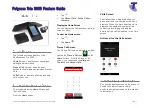
for AFH to work. There is no AFH when connecting and discovering devices. Avoid making Bluetooth
connections and discoveries during critical 802.11b communications.
AFH for Bluetooth consists of four main sections:
• Channel Classification - A method of detecting an interference on a channel-by-channel basis, or
pre-defined channel mask.
• Link Management - Coordinates and distributes the AFH information to the rest of the Bluetooth
network.
• Hop Sequence Modification - Avoids interference by selectively reducing the number of hopping
channels.
• Channel Maintenance - A method for periodically re-evaluating the channels.
The Bluetooth radio in this device operates as a Class 2 device power class. The maximum output
power is 2.5 mW and the expected range is 10 meters (32.8 ft.). A definition of ranges based on power
class is difficult to obtain due to power and device differences, and whether one measures open space
or closed office space.
NOTICE:
It is not recommended to perform Bluetooth wireless technology inquiry when high
rate 802.11b operation is required.
Return to Process
11.3.2
Bluetooth Security
This section describes Bluetooth security.The current Bluetooth specification defines security at the link
level. Application-level security is not specified. This allows application developers to define security
mechanisms tailored to their specific need. Link-level security occurs between devices, not users, while
application-level security can be implemented on a per-user basis. The Bluetooth specification defines
security algorithms and procedures required to authenticate devices, and if needed, encrypt the data
flowing on the link between the devices. Device authentication is a mandatory feature of Bluetooth
while link encryption is optional.
Pairing of Bluetooth devices is accomplished by creating an initialization key used to authenticate the
devices and create a link key for them. Entering a common personal identification number (PIN) in the
devices being paired generates the initialization key. The PIN is never sent over the air. By default, the
Bluetooth stack responds with no key when a key is requested (it is up to user to respond to the key
request event). Authentication of Bluetooth devices is based-upon a challenge-response transaction.
Bluetooth allows for a PIN or passkey used to create other 128-bit keys used for security and
encryption. The encryption key is derived from the link key used to authenticate the pairing devices.
Also worthy of note is the limited range and fast frequency hopping of the Bluetooth radios that makes
long distance eavesdropping difficult.
Recommendations are:
• Perform pairing in a secure environment
• Keep PIN codes private and do not store the PIN codes in the device
• Implement application-level security
Return to Process
on page 164
MN003477A01-A
Chapter 11: Wireless
165
Summary of Contents for LEX L10ig
Page 2: ......
Page 4: ...This page intentionally left blank ...
Page 6: ...This page intentionally left blank ...
Page 8: ...This page intentionally left blank ...
Page 18: ...This page intentionally left blank ...
Page 66: ...This page intentionally left blank ...
Page 104: ...This page intentionally left blank ...
Page 118: ...This page intentionally left blank ...
















































